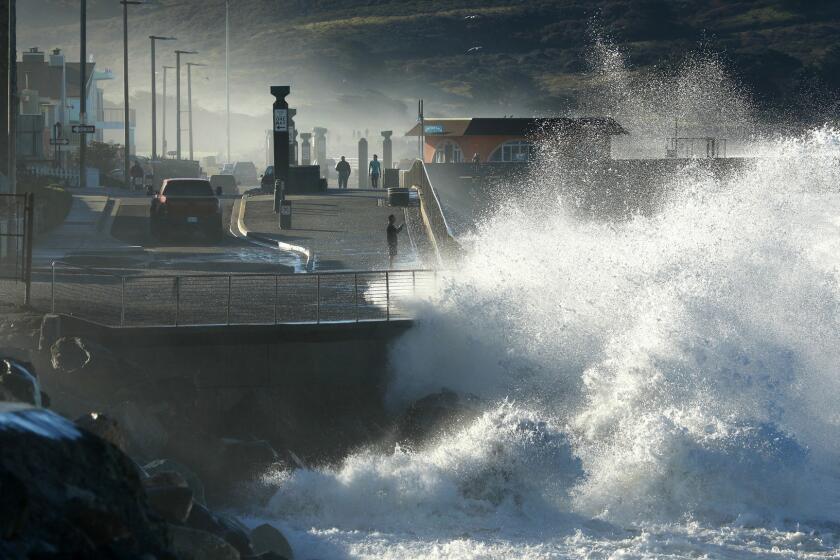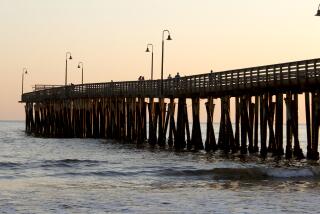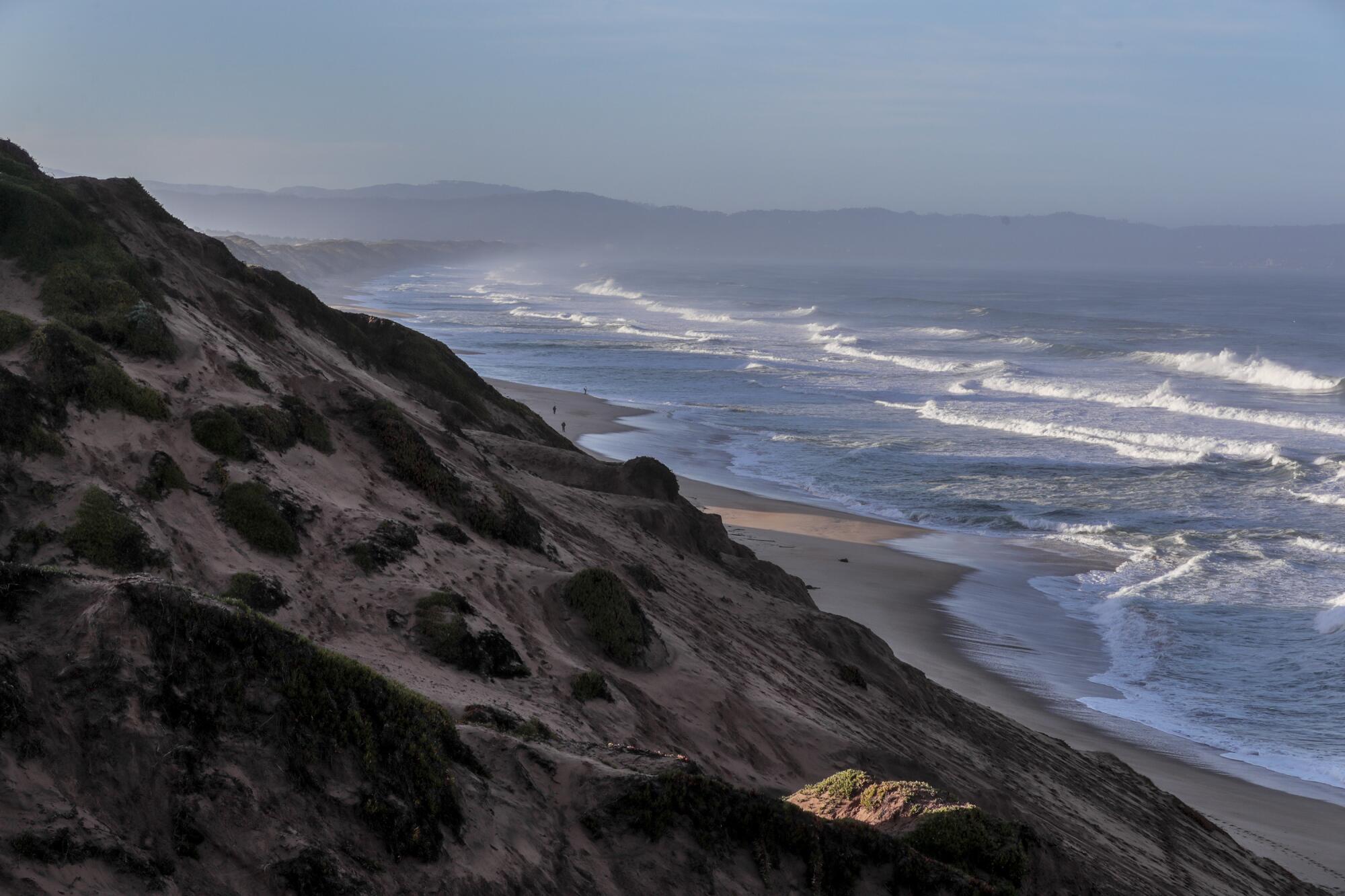
- Share via
MARINA, Calif. — Ten miles north of Monterey and a world away from Santa Cruz, Bruce Delgado gazed up a towering sand dune. Careful not to step on the beach buckwheat that protects rare butterflies or the sea lettuce that survives only in stable habitats, he wound his way toward the ocean.
At the top, slightly out of breath, he marveled at the sandy beach that stretched for miles along the bay. Big surf broke into rhythmic cusps by the shore. A red-tailed hawk soared over his town of Marina, where despite its name, no dock or pier exists to interrupt this view.
Not much of the California coast feels like this anymore, with no pavement or harbors or parking lots right up to high tide. Home to sharks and coyotes, shorebirds and butterflies, this little town not far from Silicon Valley is a reminder that the beach itself used to be wild.
“It’s the best-kept secret. Living in Marina is a choice,” said Delgado, a botanist turned mayor who has managed to pull off what many towns have not. “Sometimes when you go jogging on the beach, you see vultures eating dead sea lions. … There’s a lot of nature happening in these dunes.”
At a time when Del Mar, Pacifica and other coastal cities are fighting to defend their homes and roads from the rising sea, Marina has embarked on a path less traveled. Here in this Army turned university town, residents are learning how to adjust with the ocean as the water moves inland.
Sea walls are forbidden, and sand replenishment projects seem unnatural in a city so proud of its native environment. Officials instead are embracing ideas that have been political suicide elsewhere: Require real estate disclosures for sea level rise, move infrastructure away from the water, work with the private resort in town to relocate its oceanfront property — a policy known as managed retreat.
This small but lively town of 23,000 says it’s fought enough coastal issues over the decades to know that bad ideas must be stopped sooner than later. A controversial sand mine on the beach is finally shutting down after a century of dredging away the coast. Residents are still fighting a large water company trying to build a desalination plant.
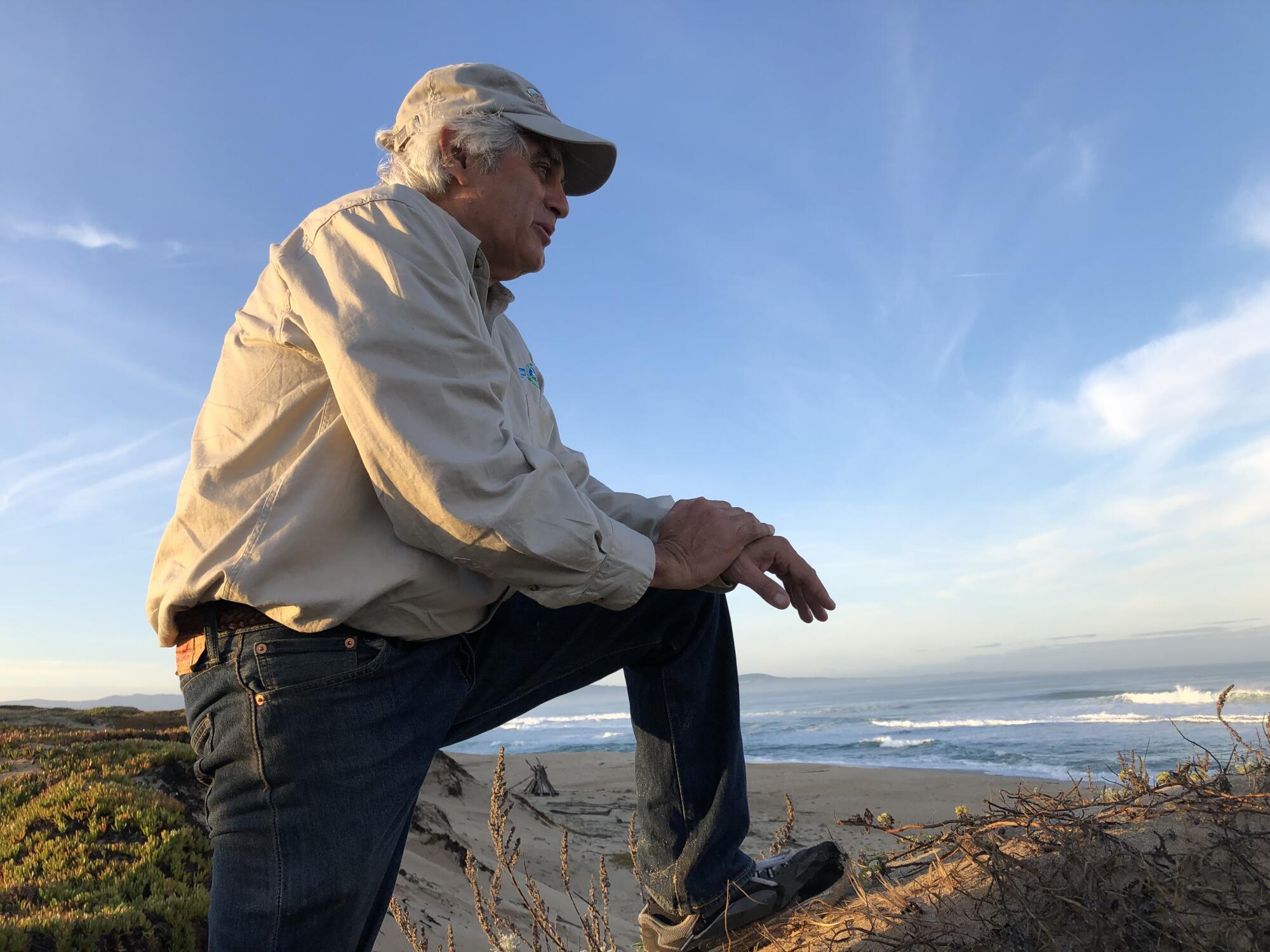
With sea level rise, the mere suggestion of making room for the ocean and turning prime real estate into open space has upended other cities up and down the coast — at least one mayor has been ousted. But Marina is different, a city report declared, and instead will show the state and country how to adapt to a changing planet.
“Marina is such a good test case,” said David Revell, a coastal geomorphologist who has advised numerous cities, including Marina, on sea level rise. “Here we have the precedent of a community who understands that … there has to be enough lead time to get things out of the way — before it’s in the way.
“That is a really powerful message to the rest of California.”
::
Accepting the strength of the ocean has long been part of Marina’s history. For decades, the region was defined by Ft. Ord, a sprawling Army base that once was home to as many as 50,000 troops. Soldiers coveted assignments here, but large waves, rip currents and unstable cliffs made the beach too dangerous to enjoy.
By 1994, the Army had packed up and left — the largest military base closure in the United States at the time. A sign today, where a building once stood, describes “a coastal attack the Army couldn’t stop.”
“Soldiers once guarded this shoreline against sea-borne attack, but one force proved too powerful to stop. Coastal erosion, the wearing away of these bluffs and beaches by ocean waves, has been steadily moving the coastline inland,” according to the sign, which said that the bluffs at Ft. Ord erode landward 5 to 8 feet a year.
Part of the land was turned into a new university, Cal State Monterey Bay; another swath was transformed into Ft. Ord National Monument. California State Parks cleaned up the coastal stretch — about four miles of beach — and plans to construct new campgrounds for the public.
The city of Seaside owns a portion, and Marina is still figuring out how to develop more than 1,000 acres on the inland side of Highway 1 (the site contamination and labor costs have not been the easiest sell to developers).
Delgado, a botanist for the Bureau of Land Management, moved here in 1996 to work on the restoration. He got swept into local politics in 1999, when he heard that city leaders wanted to turn open space into 3,500 large homes, positioning Marina as a bedroom community for a new corporate business park over the hill.
He went door to door with neighbors and got Marina to create an “urban growth boundary” north of town for at least 20 years.
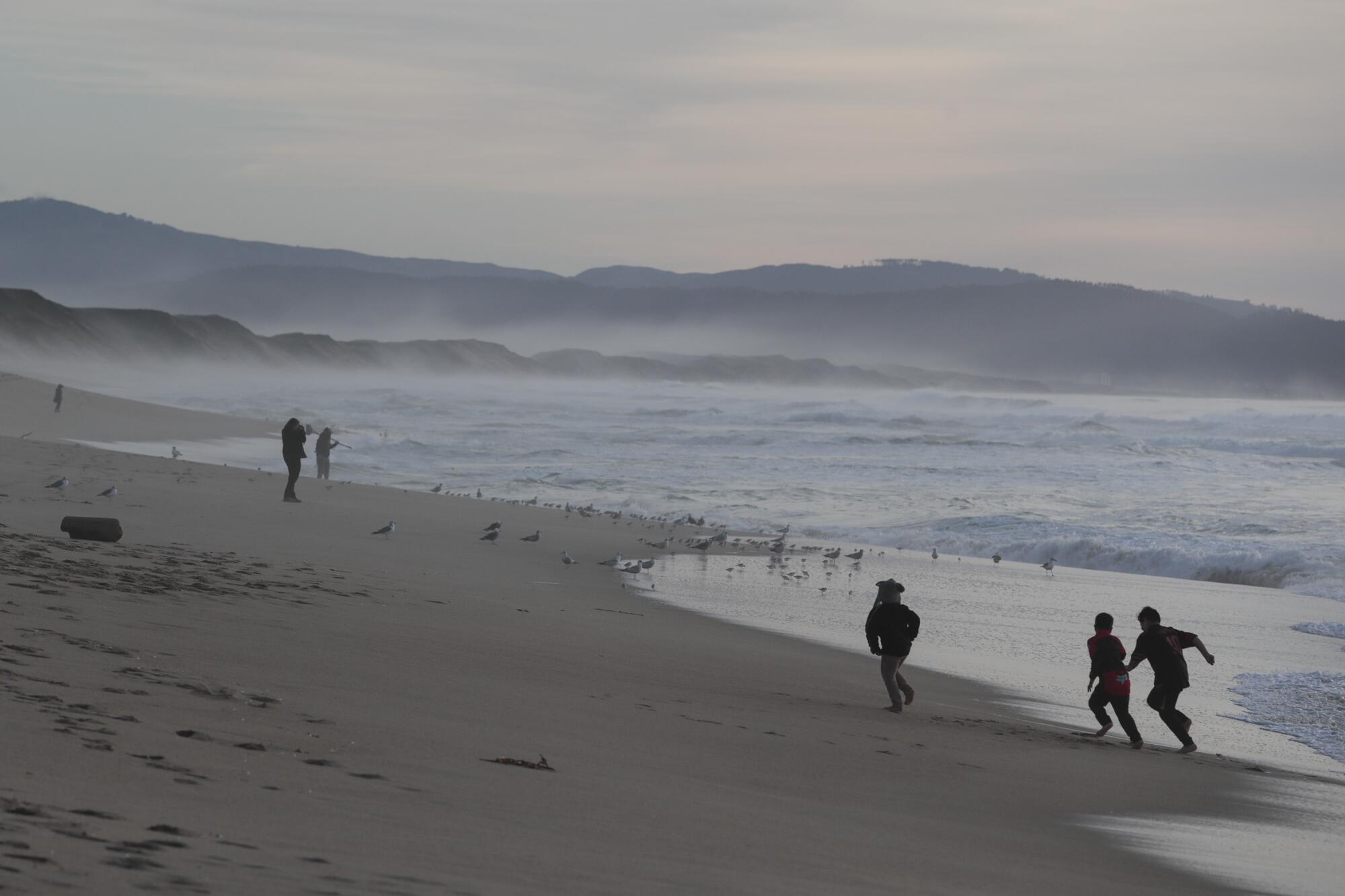

Much of the shoreline remains undeveloped — making decisions today a lot less complicated when it comes to planning for sea level rise. The city points developers instead to parcels downtown and farther inland. A new planned community, Sea Haven, is now advertising the benefits of “homes near the sea.”
Delgado grew up in Southern California going to Laguna Beach and Dana Point and has watched those sleepy beach towns greenlight multimillion-dollar homes and transform their shorelines into tourist destinations.
Marina could certainly use some of that tax revenue (it just got enough money for a new firetruck), but Delgado doesn’t envy other mayors who now have to grapple with the politics of telling their wealthiest residents what to do with their oceanfront properties.
“With sea level rise, as with development, cities like Marina are taking it seriously and logically,” he said. “We’re not going to lament that our predecessors didn’t take this seriously. We’re not going to wait until emergencies happen to take action.”
::
Marina’s coast has one of the highest rates of erosion in California — exacerbated by a Mexico-based company, Cemex, that for decades had been trucking away sand unchecked. Scientists estimate the mine alone has eroded an average of 4 feet of coast each year.
High silica content in this region makes the sand valuable for sandblasting, filtration and surface finishing. Other operations along Monterey Bay have shut down over the years, but Marina continues to watch in horror the massive hole in its beach, where machines roar all day as they suck away sand.
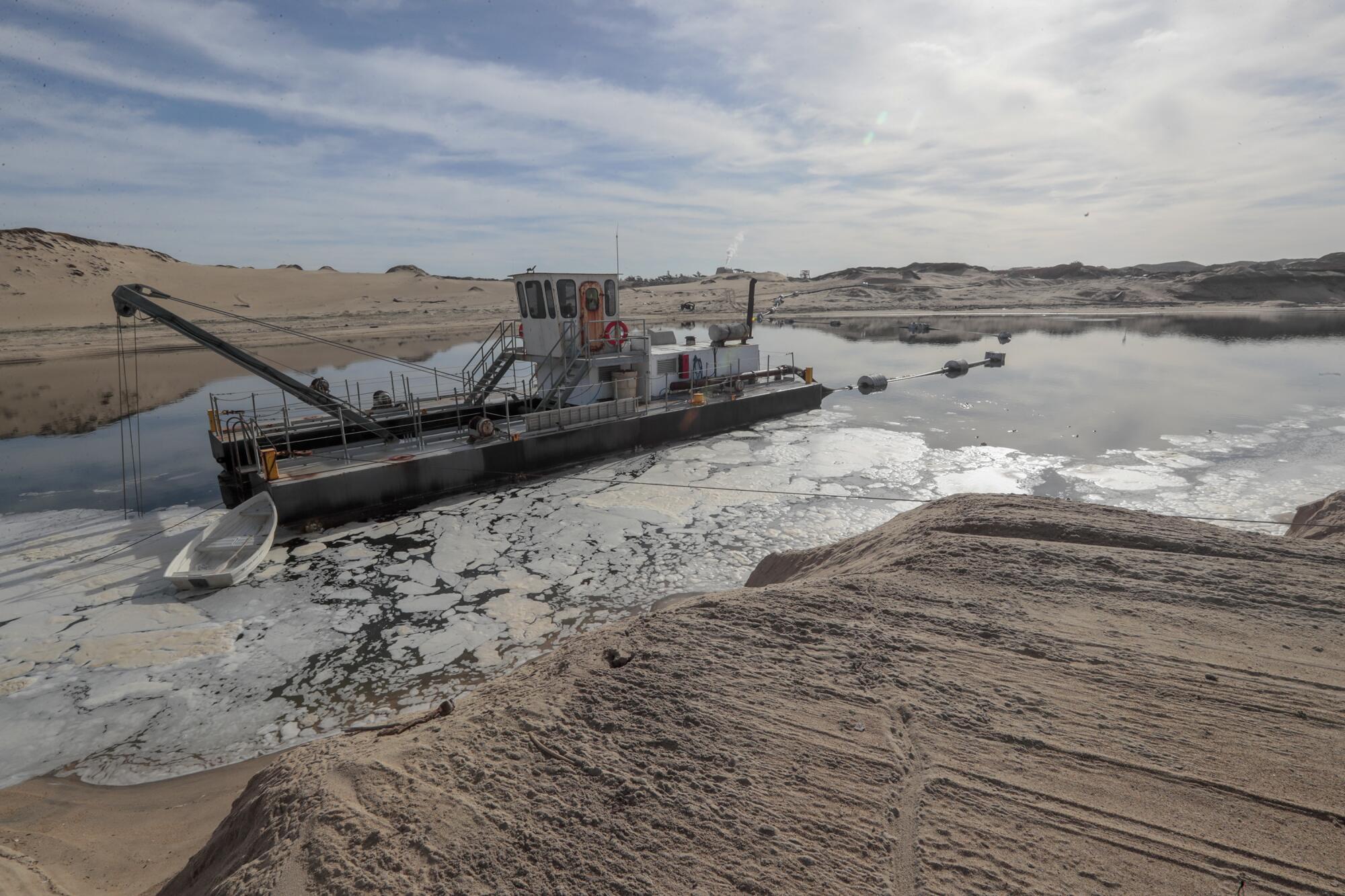
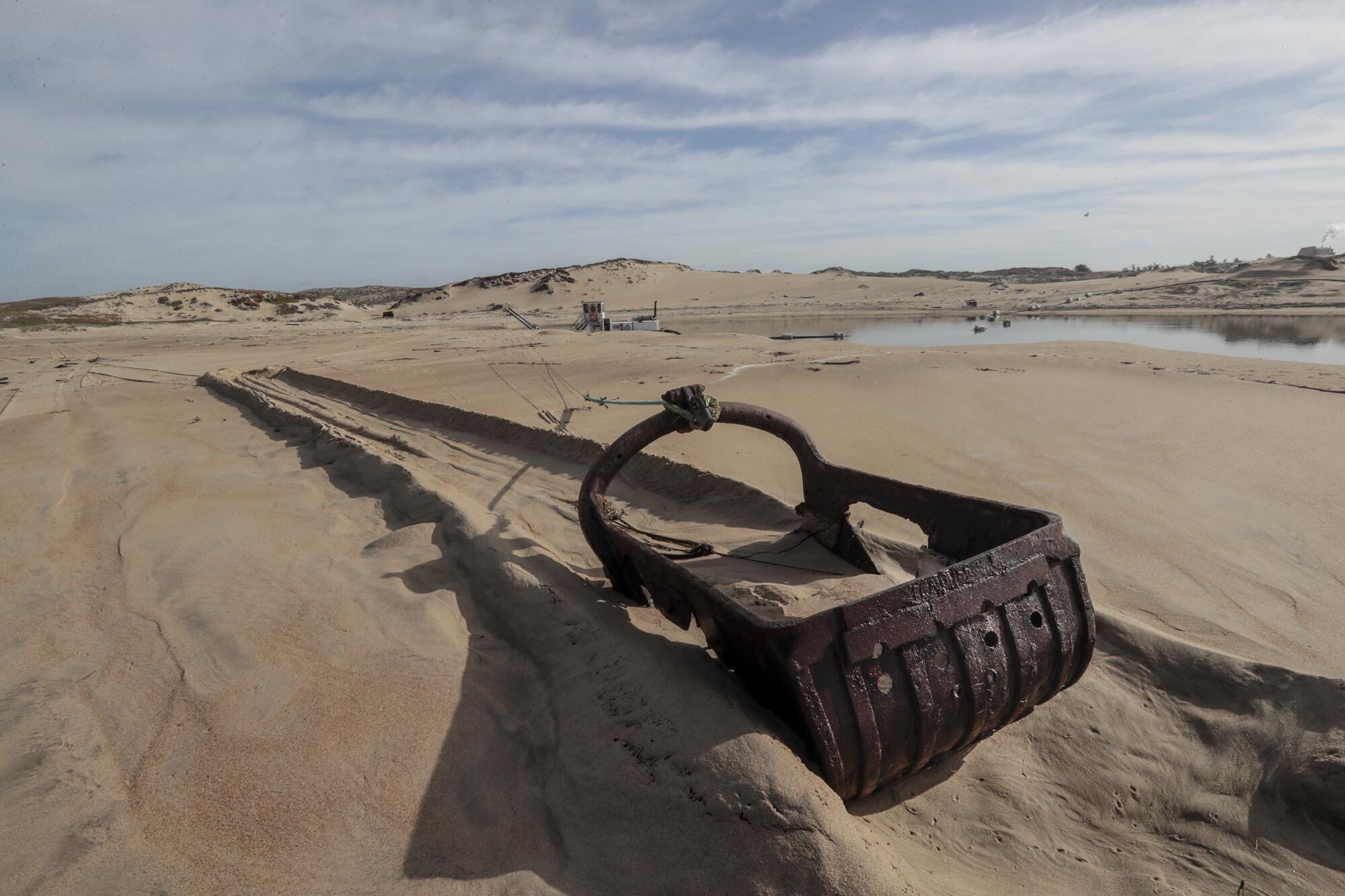
Stopping this mine would dramatically slow down the impacts of sea level rise — giving everyone more time to adapt, said Layne Long, the city manager. Marina’s dunes, even at 100 feet tall, are noticeably shrinking from a net loss of sand each year.
After years of controversy, Cemex will phase out operations by the end of this year. The company has three years to move out and sell the land to a nonprofit or government agency that would preserve the property in perpetuity and provide public access.
Residents are now fighting California American Water’s proposal to use part of this site for a desalination project. The water wouldn’t even serve Marina, they said, and building new infrastructure on an eroding coast just doesn’t sound like smart planning.
Long, on a recent walk to the mine, shook his head at the smell of machinery on the beach and the smokestacks in the distance. He envisions a restored coastline with nature trails and overlooks, perhaps even signs teaching visitors about sea level rise.
Marina has long understood the consequences of coastal erosion, unlike other towns that are just starting to debate the trade-offs. As more than 35 coastal cities and counties in California agonize over the difficult costs and choices, Marina stands out as a community enthusiastic about choosing managed retreat.
Years of fighting corporate interests, Long said, has unified the town on how to plan for sea level rise.
“We have a shot to do it right.… Because of the way we developed, and didn’t develop, we have the ability to have a very good managed retreat process,” he said. “Adopting this plan will ensure for our future generations that our coast is going to remain this way.”
::
The city’s sea level rise plan, now in its final stages, has received little resistance. In a town where one-third of the community is low income and more than 60% are not white, maintaining a coastline that can be enjoyed by all is top priority. In meetings and surveys, residents urged city leaders to protect their beaches if pressure from private property owners or business interests takes hold.
At a recent public workshop, officials reaffirmed their commitment to banning sea walls and were wary of any suggestions that sounded unnatural. They talked about their vision to protect the city from “the negative impacts of urban sprawl” while still growing economically as “a desirable residential and business community in a natural setting.”
The plan lays out a framework over the next few decades for when office buildings, a sewer pump and an aging water treatment facility should consider moving away from the sea. Beach amenities, such as a parking lot and public restrooms, might also need to relocate.
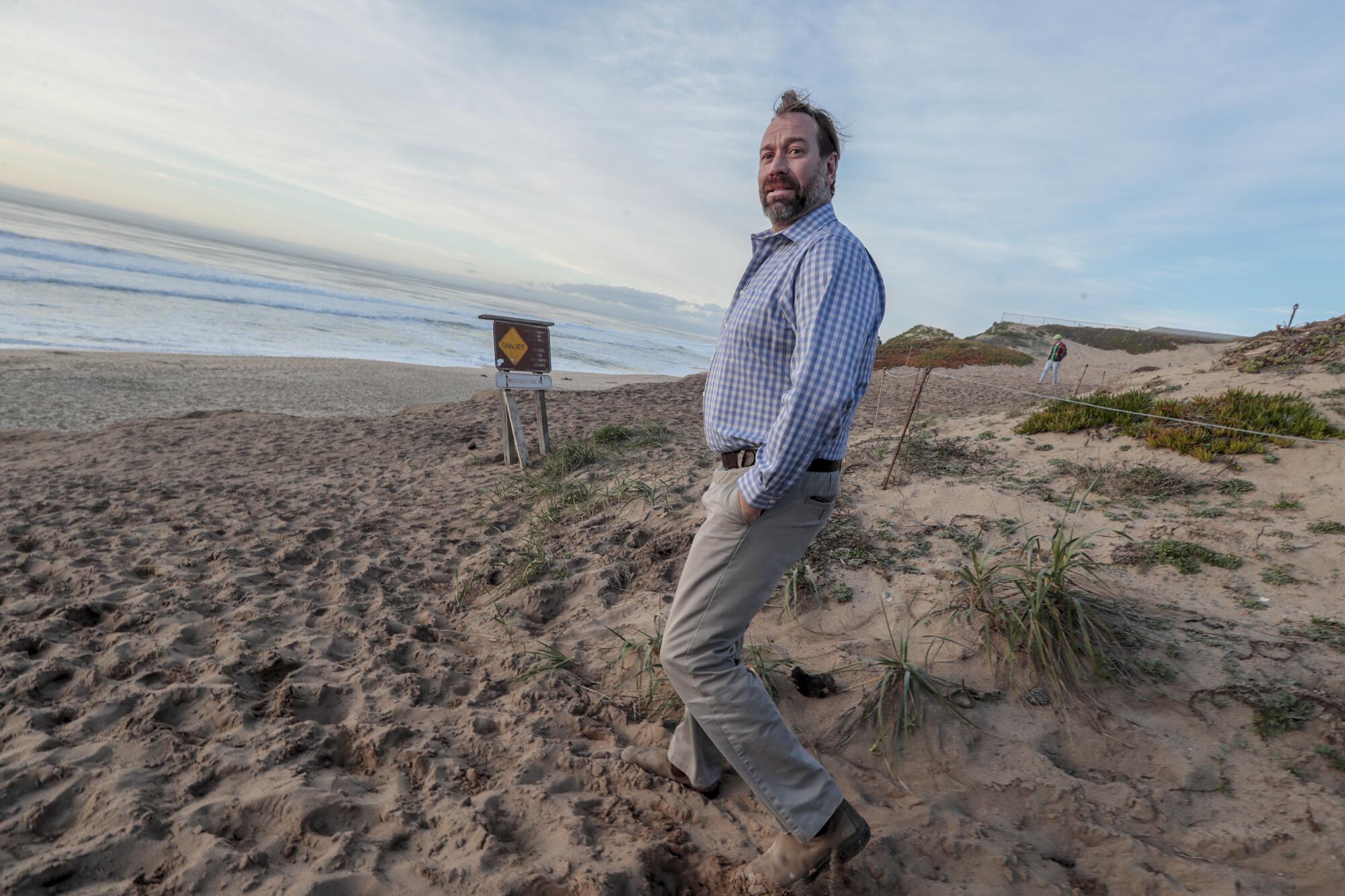
Triggers will be identified on when these decisions should be made, based on how much time it takes to permit new construction. When the sea rises to a certain threshold or erosion gets within a certain distance, for example, park officials should begin plans to move the parking lot — rather than just cornering off sections when they collapse.
As for private property, city planners broached the Sanctuary Beach Resort about checking in every renovation cycle, about five to seven years, to consider when might be a good time to move nine oceanfront buildings without sacrificing the total number of rooms — perhaps by turning some of the resort’s single-story cottages into two-story accommodations farther inland.
Jeroen Gerrese, the resort‘s general manager and chair of the Monterey County Hospitality Assn., said he is open to further discussions on how to accommodate the environment and preserve what makes the resort special.
Unlike other resorts along the peninsula, which are closer to attractions such as the Pebble Beach golf course and the Monterey wharf, his is the only one that can offer beach walks and sunset bonfires and direct access to the sand.
“Everyone else can look at the ocean,” Gerrese said, “but they can’t get there from their resort.”
Walking along an unpaved path, he pointed to the bocce ball court made from recycled oyster shells, the pastel-colored bikes offered to guests, the limited use of plastic. Born in the Netherlands below sea level, Gerrese says he respects the water a great deal. Now a resident of Marina, he jumps at opportunities to recruit from the local university and plants trees around town.
Taking care of the environment is part of the business plan and a shared duty, he said, stooping down to pick up a rogue candy wrapper. “If you don’t think about working with nature, you’re not true to yourself as a business owner and not true to your community that you reside in.”
He looks up and admires the surf crashing onto shore. There’s no point fighting, he said, a force as powerful as the ocean.
More to Read
Sign up for Essential California
The most important California stories and recommendations in your inbox every morning.
You may occasionally receive promotional content from the Los Angeles Times.
